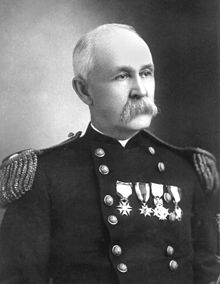George M. Sternberg
| George Miller Sternberg | |
|---|---|

Brigadier General George Miller Sternberg
|
|
| Born |
June 8, 1838 Otsego County, New York |
| Died | November 3, 1915 (aged 77) Washington, D.C. |
| Buried | Arlington National Cemetery |
| Allegiance | United States of America |
| Service/branch | United States Army |
| Years of service | 1861–1902 |
| Rank | Brigadier General |
| Commands held | U.S. Army Surgeon General |
| Battles/wars | Spanish–American War |
Brigadier General George Miller Sternberg (June 8, 1838 – November 3, 1915) was a U.S. Army physician who is considered the first U.S. bacteriologist, having written Manual of Bacteriology (1892). After he survived typhoid and yellow fever, Sternberg documented the cause of malaria (1881), discovered the cause of lobar pneumonia (1881), and confirmed the roles of the bacilli of tuberculosis and typhoid fever (1886).
As the 18th U.S. Army Surgeon General, from 1893 to 1902, Sternberg led commissions to control typhoid and yellow fever, along with his subordinate Major Walter Reed. Sternberg also oversaw the establishment of the Army Medical School (1893; now the Walter Reed Army Institute of Research) and of the U.S. Army Nurse Corps (1901). The pioneering German bacteriologist Robert Koch honored Sternberg with the sobriquet, "Father of American Bacteriology".
Sternberg was born at Hartwick Seminary, Otsego County, New York, where he spent most of his childhood. He was the eldest child of Levi Sternberg and Margaret Miller Stenberg. His father was a Lutheran clergyman, was descended from a German family from the Palatinate, which had settled in the Schoharie Valley in the early years of the 18th century. His father later became principal of Hartwick Seminary in Oneonta, New York, where he atarted his education. His mother, Margaret Levering (Miller) Sternberg, was the daughter of George B. Miller, also a Lutheran clergyman and professor of theology at the seminary, which was a Lutheran school. As an eldest child of a large family and he was given adult responsibilities from an early age. He interrupted his studies at the seminary with a year of work in a bookstore in Cooperstown and three years of teaching in nearby rural schools. During his last year at Hartwick he was an instructor in mathematics, chemistry, and natural philosophy. He was at the same time pursuing the study of medicine with Horace Lathrop of Cooperstown. For his formal medical training he went first to Buffalo, and later to the College of Physicians and Surgeons of New York (M.D. degree, 1860). After graduation he settled in Elizabeth, New Jersey to practice, remaining there until the outbreak of the Civil War.
...
Wikipedia
